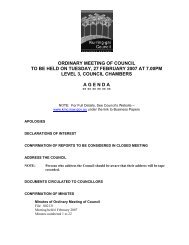Pymble Business Park - Ku-ring-gai Council
Pymble Business Park - Ku-ring-gai Council
Pymble Business Park - Ku-ring-gai Council
Create successful ePaper yourself
Turn your PDF publications into a flip-book with our unique Google optimized e-Paper software.
6.3 LANDSCAPING (continued)<br />
6<br />
Objectives<br />
Controls<br />
7 To integrate landscape<br />
design and biodiversity<br />
protection with bushfire<br />
management.<br />
8 To contribute to climate<br />
control by retaining and<br />
planting trees to capture<br />
atmospheric carbon.<br />
9 To promote climate<br />
change adaptation<br />
through landscape design<br />
which minimises water<br />
use, provides for summer<br />
shade, is resilient to<br />
storms, consolidates and<br />
interconnects vegetation,<br />
habitat and waterways,<br />
and minimises bushfire<br />
risk.<br />
Figure 6.3-2<br />
Trees planted in groups are<br />
more resilient to storms<br />
7 The introduction of imported soils and disturbance of local seed<br />
banks must be avoided wherever possible.<br />
8 Vegetation retention and planting must also consider resilience:<br />
i) Healthy undamaged specimens are to be the first priority for<br />
conservation, particularly habitat trees;<br />
ii) While single trees may be ecologically important in their own<br />
right, or as part of a broader community, retaining and planting<br />
trees in groups generally provide increased resilience to storm<br />
events.<br />
Note 1: Works within an area containing critical habitat, threatened species,<br />
populations, or threatened ecological communities may require a fl ora and fauna<br />
assessment in accordance with Part 5A of the Environmental Planning and<br />
Assessment Act (1979). Works that have a signifi cant impact on the above are<br />
integrated development requi<strong>ring</strong> referral to at least one government agency.<br />
Note 2: Matters of National Environmental Signifi cance must also be considered<br />
under the Environmental Protection and Biodiversity Conservation Act (1999). This<br />
process is managed externally to <strong>Council</strong>. These matters include migratory species,<br />
threatened species, populations and ecological communities listed under the Act.<br />
9 Siting and choice of trees must consider:<br />
i) good solar access to useable open space areas;<br />
ii) provision of summer shade;<br />
iii) proximity to buildings, fences, and other structures;<br />
iv) proximity to stormwater, electricity, gas, sewer, other<br />
infrastructure and services; and<br />
v) the potential hazard on sites prone to bushfire risk (refer to<br />
Planning for Bushfire Protection 2006).<br />
Bushland Protection<br />
10 Where stands of bushland are on or adjacent to a development site,<br />
a landscape buffer zone is to be established on the development site<br />
between the proposed development and the bushland. The width of<br />
the landscape buffer zone is to be determined having regard to:<br />
i) the location of natural drainage lines and riparian zones;<br />
ii) the presence of habitat, threatened species, populations or<br />
communities; and<br />
iii) the need for an asset protection zone.<br />
SITE DESIGN<br />
11 Where development is adjacent to bushland, a riparian zone or other<br />
significant vegetation or habitat, the applicant must demonstrate<br />
how the ecological values will be protected. <strong>Council</strong> may require an<br />
environmental or vegetation management plan in this regard.<br />
Draft <strong>Ku</strong>-<strong>ring</strong>-<strong>gai</strong> Principal Development Control Plan 2012<br />
p 57

















